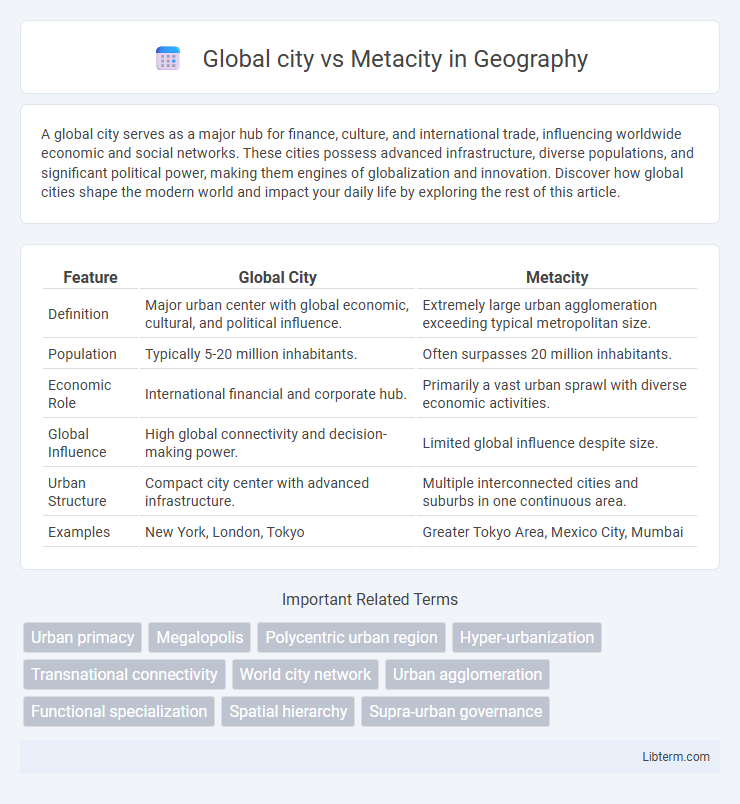A global city serves as a major hub for finance, culture, and international trade, influencing worldwide economic and social networks. These cities possess advanced infrastructure, diverse populations, and significant political power, making them engines of globalization and innovation. Discover how global cities shape the modern world and impact your daily life by exploring the rest of this article.
Table of Comparison
| Feature | Global City | Metacity |
|---|---|---|
| Definition | Major urban center with global economic, cultural, and political influence. | Extremely large urban agglomeration exceeding typical metropolitan size. |
| Population | Typically 5-20 million inhabitants. | Often surpasses 20 million inhabitants. |
| Economic Role | International financial and corporate hub. | Primarily a vast urban sprawl with diverse economic activities. |
| Global Influence | High global connectivity and decision-making power. | Limited global influence despite size. |
| Urban Structure | Compact city center with advanced infrastructure. | Multiple interconnected cities and suburbs in one continuous area. |
| Examples | New York, London, Tokyo | Greater Tokyo Area, Mexico City, Mumbai |
Defining Global City and Metacity
A global city serves as a pivotal hub for international finance, trade, culture, and politics, characterized by its extensive connectivity and influence over global economic networks, exemplified by cities like New York and London. Metacity refers to an urban agglomeration that combines multiple large metropolitan areas into a continuous megaregion, often exceeding the scale of traditional global cities, such as the Tokyo metropolitan area or the Pearl River Delta. While global cities emphasize global economic integration and cultural influence, metacities highlight unprecedented urban scale, population density, and complex infrastructure spanning vast geographic regions.
Key Characteristics of Global Cities
Global cities exhibit significant economic power, advanced infrastructure, and cultural influence, serving as central nodes in global finance, trade, and communication networks. They house major multinational corporations' headquarters, possess diverse populations, and provide extensive services like education, healthcare, and transportation. Unlike metacities, which emphasize sheer population size and urban sprawl, global cities prioritize connectivity and influence in the global economy and innovation ecosystems.
Distinct Features of Metacities
Metacities are defined by their immense population size, typically exceeding 20 million inhabitants, and their expansive spatial footprint that integrates multiple urban and suburban areas into a continuous metropolitan agglomeration. Unlike global cities, which emphasize economic influence and international connectivity, metacities prioritize infrastructural complexity and the management of diverse socioeconomic networks across vast territories. Key features of metacities include extensive multimodal transportation systems, heterogeneous population demographics, and significant challenges in sustainable urban planning and resource allocation.
Economic Influence and Connectivity
Global cities act as pivotal hubs in the world economy, concentrating finance, corporate headquarters, and international trade networks that drive global economic flows. Metacities, characterized by vast urban sprawls with populations exceeding 20 million, generate substantial economic activity but often face challenges in cohesive governance and integrated connectivity. The economic influence of global cities stems from their strategic positioning in global value chains and superior infrastructure, while metacities rely on their massive labor pools and internal market size to sustain economic dynamism.
Population Size and Urban Expansion
Global cities typically feature populations ranging from several million to over 20 million residents, characterized by significant economic influence and dense urban infrastructure. Metacities surpass these in scale, often exceeding 30 million inhabitants and sprawling across vast geographical areas with extensive suburban and peri-urban zones. The urban expansion of metacities reflects rapid demographic growth and increased spatial complexity, posing unique challenges for sustainable development and infrastructure management.
Governance and Urban Management
Global cities like New York and London exhibit complex governance structures involving multiple stakeholders, including local governments, private sectors, and international organizations, enabling coordinated urban management and economic integration on a worldwide scale. Metacities, characterized by populations exceeding 20 million, often face fragmented governance challenges due to overlapping jurisdictions and infrastructure demands, complicating urban management efforts. Effective governance in metacities requires innovative frameworks that enhance collaboration across metropolitan regions to address issues such as transportation, housing, and environmental sustainability.
Social and Cultural Diversity
Global cities like New York and London serve as hubs for diverse populations, fostering multiculturalism through immigration and international business networks. Metacities, often characterized by their vast size and dense populations, exhibit more intense social stratification and localized cultural variations within their sprawling urban landscapes. Both urban forms contribute uniquely to social and cultural diversity, with global cities emphasizing international connectivity and metacities highlighting complex internal diversity dynamics.
Challenges Facing Global Cities vs Metacities
Global cities encounter challenges such as overcrowding, infrastructure strain, and socio-economic disparities driven by intense urbanization and international economic integration. Metacities face amplified difficulties including managing megaregional governance, ensuring equitable resource distribution, and mitigating environmental impacts at a much larger scale due to their expansive geographic and demographic scope. Both require advanced urban planning and sustainable development strategies to address complex mobility, housing, and public service demands.
Sustainability and Urban Resilience
Global cities prioritize economic influence and connectivity while integrating sustainability through green infrastructure and smart technologies to enhance urban resilience against climate change impacts. Metacities, characterized by vast populations exceeding 20 million, face complex sustainability challenges such as resource management and pollution, requiring advanced multi-level governance and adaptive urban planning to ensure resilience. Both urban forms emphasize innovative solutions like renewable energy adoption and flood mitigation systems to strengthen environmental sustainability and disaster preparedness.
Future Trends in Global Urbanization
Future trends in global urbanization highlight the rapid emergence of metacities, defined as urban agglomerations exceeding 20 million inhabitants, surpassing traditional global cities like New York or London in scale and complexity. Innovations in smart infrastructure, sustainability initiatives, and digital connectivity will drive metacities' evolution, accommodating massive population inflows while addressing climate resilience and resource management. The transition from global cities to metacities signals a shift towards multi-nodal urban networks with integrated transportation and decentralized economies shaping the future of urban living.
Global city Infographic

 libterm.com
libterm.com